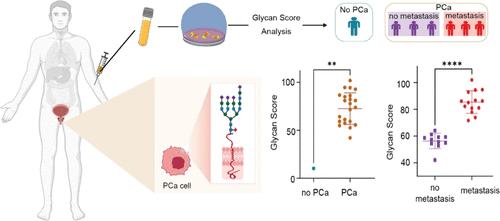液体活检糖类评分生物标记物能准确显示和分层原发性和转移性前列腺癌
IF 6.7
1区 化学
Q1 CHEMISTRY, ANALYTICAL
引用次数: 0
摘要
前列腺癌(PCa)是最常见的男性癌症。早期 PCa 通常没有临床症状,目前主要通过对血清前列腺特异性抗原(PSA)进行液体活检来诊断。这种检测的假阳性率和假阴性率都很高。因此,为液态活检精确检测 PCa 找出新的生物标记物是临床的迫切需求。在这里,我们使用一种先进的双功能适配体测定法,量化了癌症患者血清中循环的 PSA 的糖基化程度,将其与 PSA 与血清循环蛋白复合物的癌症相关断裂联系起来,并证明了它可用于原发性和转移性 PCa 的分层。PSA 的 "Glycan Score "100%准确地告知了 30 名患者的 PCa 状态,而血清 PSA 浓度仅能正确地对 53% 的 PCa 患者进行分层,无法告知他们的 PCa 状态。因此,"糖分 "液体活检测试在准确诊断和分期 PCa、开展大规模筛查计划和监测 PCa 治疗进展方面具有巨大潜力。本文章由计算机程序翻译,如有差异,请以英文原文为准。

Liquid-Biopsy Glycan Score Biomarker Accurately Indicates and Stratifies Primary and Metastatic Prostate Cancers
Prostate cancer (PCa) is the most commonly diagnosed cancer in males. Early PCa usually shows no clinical symptoms and its primary diagnosis is currently guided by liquid-biopsy testing of serum prostate-specific antigen (PSA). This testing suffers from high false-positive and false-negative rates. Identifying new biomarkers for precise liquid-biopsy detection of PCa is, thus, an acute clinical request. Here, by using an advanced dual-functional aptamer assay, we quantified the extent of glycosylation of PSA circulating in cancer patients’ serum, linked it to cancer-related breakage of PSA complexes with serum-circulating proteins, and proved its facility for stratification of primary and metastatic PCa. PSA’s “Glycan Score” 100% accurately informed about PCa status in a 30-patient cohort, while serum PSA’s concentration correctly classified only 53% of PCa patients and did not inform about their PCa status. The Glycan Score liquid-biopsy test thus has a huge potential for accurate diagnosis and staging of PCa, enabling mass-screening program progress and advanced PCa treatment monitoring.
求助全文
通过发布文献求助,成功后即可免费获取论文全文。
去求助
来源期刊

Analytical Chemistry
化学-分析化学
CiteScore
12.10
自引率
12.20%
发文量
1949
审稿时长
1.4 months
期刊介绍:
Analytical Chemistry, a peer-reviewed research journal, focuses on disseminating new and original knowledge across all branches of analytical chemistry. Fundamental articles may explore general principles of chemical measurement science and need not directly address existing or potential analytical methodology. They can be entirely theoretical or report experimental results. Contributions may cover various phases of analytical operations, including sampling, bioanalysis, electrochemistry, mass spectrometry, microscale and nanoscale systems, environmental analysis, separations, spectroscopy, chemical reactions and selectivity, instrumentation, imaging, surface analysis, and data processing. Papers discussing known analytical methods should present a significant, original application of the method, a notable improvement, or results on an important analyte.
 求助内容:
求助内容: 应助结果提醒方式:
应助结果提醒方式:


